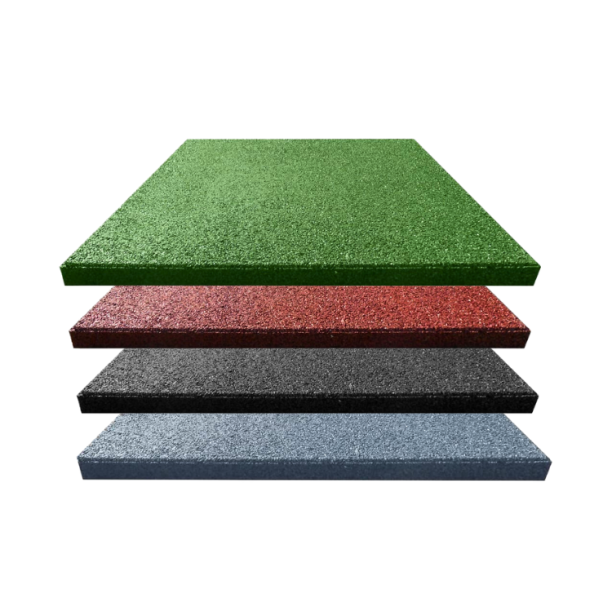Rubber Safety Playground Tiles 50*50*2.5 / sqm

Rubber Safety Playground Tiles 50*50*2.5 / sqm
In stock
Echipament profesional pentru spații comerciale și publice.
Main Features
Description
Specifications
Rubber tiles are a versatile and safe choice for a variety of applications, providing a comfortable and durable environment for outdoor and indoor activities.
What are rubber tiles?
Rubber tiles are obtained in two different ways: EPDM rubber tiles and SBR rubber tiles. SBR (styrene-butadiene) material makes up more than 50% of the rubber produced worldwide and is much more accessible compared to other rubber materials. Customer preferences vary depending on the usage area, and SBR rubber flooring material is preferred, especially in outdoor areas.
What are the benefits of rubber tiles?
Flexibility: Rubber tiles are flexible and soft, making them comfortable for walks and physical activities.
Resistance and Durability: They are resistant and have a long lifespan, withstanding the rigors of heavy use over time.
Safety: They are slip-resistant, non-stick, and heat-resistant, providing a safe surface for both children and adults.
Environmentally Friendly: Rubber tiles are made from recycled materials and do not contain harmful substances to the environment or health. They are non-toxic and UV-resistant.
Weather Resistance: They can be used in any weather conditions without losing their properties, resistant to freezing/thawing, non-slip, and permeable.
Easy Installation and Maintenance: Their shape allows for easy installation in landscaping applications.
Shock Absorption: Their structure helps absorb shocks, making them ideal for surfaces where there is a risk of falls.
Where can rubber tiles be used?
Rubber surfaces are used in various fields, including:
- Parks: Rubber tiles offer many advantages due to their varied color and pattern options.
- Children's playgrounds, daycares, and kindergartens: They reduce the risk of injury in case of falls due to their flexibility and impact resistance.
- Sports facilities: They provide a softer feel for gymnastics movements and reduce the impact of weight in training areas.
- Terraces, gardens, yards, pathways: They provide a pleasant walking experience.
- Shooting ranges: Minimize sound and impact.
- Animal shelters: Adapt to all weather conditions.
- Outdoor fitness and sports areas: Basketball, soccer, and volleyball in parks.
Many other areas, such as training tracks, garage entrances, or rehabilitation centers.
How are rubber tiles installed and maintained?
- Check the surface: Rubber pavers can be installed on various surfaces such as concrete, asphalt, cement, sand, gravel, or soil. Ensure that the surface on which you will install the rubber tiles is even, without major irregularities or holes.
- Compact and level the surface: To achieve proper installation and a stable surface, it is essential to compact and level the surface where you will install the rubber tiles.
- Ensure water drainage: When installing on a concrete base, ensure a drainage slope of 1-2% to allow efficient water drainage.
- Installation itself: Installing rubber tiles is straightforward, simply arrange them in the desired configuration. Pay special attention to the positioning of the first tiles, as they will influence the arrangement of successive elements and the overall appearance of the work.
- Wash the tiles: It is recommended to wash rubber pavers with a water hose to remove dust and debris. If using a pressure washer, make sure the pneumatic nozzle is held at least 30 cm away from the rubber tiles to avoid damaging them.
- Tile maintenance: For rubber tile maintenance, you can use a soft brush or broom for regular cleaning. In case of stains, use a damp cloth and a little soapy water to remove them.
- Side locking: It is mandatory to provide side locking at the installation boundary to ensure a solid and uniform fixation of the rubber tiles.
By following these installation and maintenance steps, tartan rubber tiles will provide a comfortable, durable, and safe surface for various sports and recreational activities.



































































































































